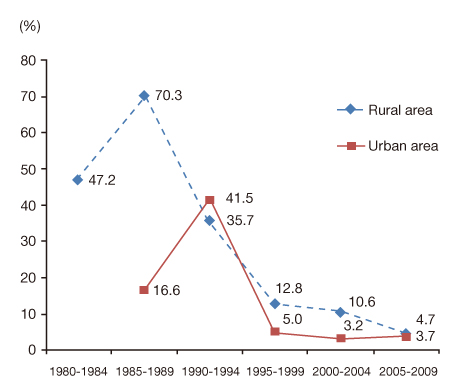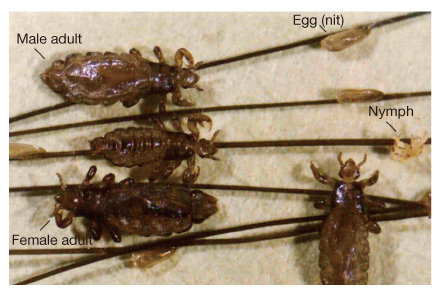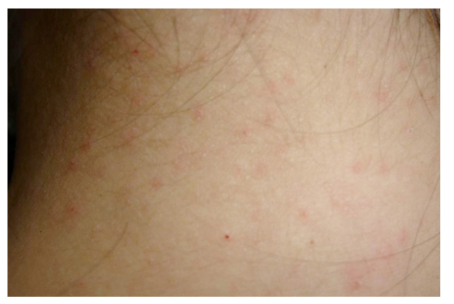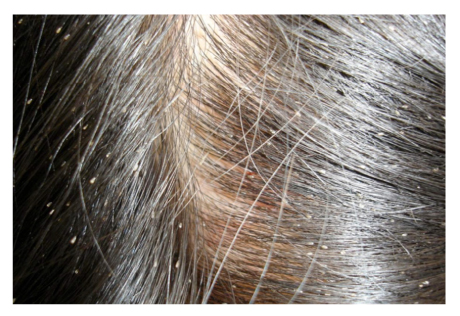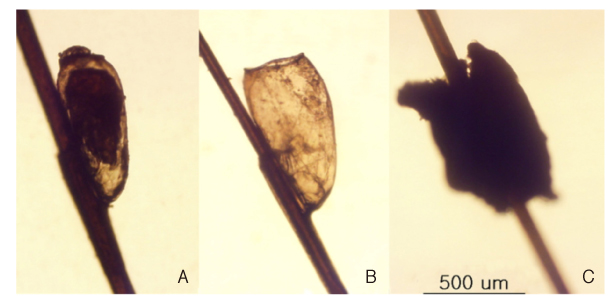 |
 |
- Search
| J Korean Med Assoc > Volume 54(5); 2011 > Article |
Abstract
The aim of this article is to provide guidelines to diagnosis and therapeutics for HLI in Korea. Head lice infestation (HLI) caused by Pediculus humanus capitis is still common in Korean children in spite of an improvement since the 1980s in the country's economic status and the concepts of hygiene. HLI is troublesome and, if not treated, can lead to secondary bacterial infection as a result of scratching of the irritated scalp induced by an inflammatory reaction to injected saliva or anticoagulant. In addition, HLI causes social and psychological problems as well as physical symptoms. Confirmation of the HLI depends on identification of adult lice, nymphs, or viable nits. Nits are more commonly found at the nape of the neck and retroauricular areas. The differential diagnosis includes hair casts, dandruff, and debris by hair spray. Few chemical shampoos such as those containing lindane or pyrethrin are currently available in Korea. Although HLI is an important public health issue in Korea, little information is available on HLI. Medical doctors, school nurses, and teachers should be acquainted with HLI for the successful control of this disease, which is distressing a number of children covertly.
References
1. Araujo A, Ferreira LF, Guidon N, Maues Da Serra Freire N, Reinhard KJ, Dittmar K. Ten thousand years of head lice infection. Parasitol Today 2000;16:269.
2. Burkhart CN, Burkhart CG. Head lice: scientific assessment of the nit sheath with clinical ramifications and therapeutic options. J Am Acad Dermatol 2005;53:129-133.
3. Sim S, Lee IY, Lee KJ, Seo JH, Im KI, Shin MH, Yong TS. A survey on head lice infestation in Korea (2001) and the therapeutic efficacy of oral trimethoprim/sulfamethoxazole adding to lindane shampoo. Korean J Parasitol 2003;41:57-61.
4. Oh JM, Lee IY, Lee WJ, Seo M, Park SA, Lee SH, Seo JH, Yong TS, Park SJ, Shin MH, Pai KS, Yu JR, Sim S. Prevalence of pediculosis capitis among Korean children. Parasitol Res 2010;107:1415-1419.
5. Lee SH, Oh CW, Chai JY. Head louse infestation among primary school children In Seosangun, Chungnam province. Korean J Parasitol 1984;22:141-143.
6. Kim TK, Park CP, Ho S. Head louse infestation among the students in Yongyang-gun, Kyongsangbuk-to. Korean J Parasitol 1984;22:273-276.
7. Pai KS, Park MS, Lee YS, Kim DH, Chung KS, Lee KY, Kim PK, Kim KY, Yong TS, Ree HI. The prevalence of head louse infestation among urban and rural children in Korea. Korean J Parasitol 1989;27:271-275.
8. Ree HI, Yong TS, Shin HJ, Shin CO, Lee IY, Seo SA, Seo JH, Chang JK, Lee DH, Im KI. Mass treatment of head louse infestation with Sumithrin powder in primary schools in Korea. Korean J Parasitol 1992;30:349-354.
9. Huh S, Pai KS, Lee SJ, Kim KJ, Kim NH. Prevalence of head louse infestation in primary school children in Kangwon-do, Korea. Korean J Parasitol 1993;31:67-69.
10. Hong HK, Kim CM, Lee JS, Lee WJ, Yang YC. Infestation rate of head lice in primary school children in Inchon, Korea. Korean J Parasitol 1995;33:243-244.
11. Ha YC, Heo JM, Kim HJ, Go GM, Lee SJ, Jeong SH, Ahn SI, Kim MC, Kim JE, Song HY, Park JW, Kim BS, Sohn WM. Infestation status of head louse and treatment with lindane shampoo in children of primary school and kindergarten in Chinju-shi, Kyongsangnam-do, Korea. Korean J Parasitol 2000;38:41-43.
12. de Berker D, Sinclair R. Getting ahead of head lice. Australas J Dermatol 2000;41:209-212.
13. Lebwohl M, Clark L, Levitt J. Therapy for head lice based on life cycle, resistance, and safety considerations. Pediatrics 2007;119:965-974.
14. Ko CJ, Elston DM. Pediculosis. J Am Acad Dermatol 2004;50:1-12.
15. Koch T, Brown M, Selim P, Isam C. Towards the eradication of head lice: literature review and research agenda. J Clin Nurs 2001;10:364-371.
16. Nash B. Treating head lice. BMJ 2003;326:1256-1257.
17. Jones KN, English JC 3rd. Review of common therapeutic options in the United States for the treatment of pediculosis capitis. Clin Infect Dis 2003;36:1355-1361.
18. Roberts RJ. Clinical practice. Head lice. N Engl J Med 2002;346:1645-1650.
19. Heukelbach J, Wilcke T, Winter B, Feldmeier H. Epidemiology and morbidity of scabies and pediculosis capitis in resource-poor communities in Brazil. Br J Dermatol 2005;153:150-156.
20. Burkhart CN, Burkhart CG. Fomite transmission in head lice. J Am Acad Dermatol 2007;56:1044-1047.
21. Scott P, Middlefell LS, Fabbroni G, Mitchell DA. Interesting case: cervical lymphadenopathy, induced by head lice. Br J Oral Maxillofac Surg 2005;43:515.
22. Mumcuoglu KY, Klaus S, Kafka D, Teiler M, Miller J. Clinical observations related to head lice infestation. J Am Acad Dermatol 1991;25(2 Pt 1):248-251.
23. Speare R, Canyon DV, Melrose W. Quantification of blood intake of the head louse: Pediculus humanus capitis. Int J Dermatol 2006;45:543-546.
24. Guss DA, Koenig M, Castillo EM. Severe iron deficiency anemia and lice infestation. J Emerg Med 2010;07. 23. [Epub]. DOI: 10.1016/j.jemermed.2010.05.030.
25. Bonilla DL, Kabeya H, Henn J, Kramer VL, Kosoy MY. Bartonella quintana in body lice and head lice from homeless persons, San Francisco, California, USA. Emerg Infect Dis 2009;15:912-915.
26. Sasaki T, Poudel SK, Isawa H, Hayashi T, Seki N, Tomita T, Sawabe K, Kobayashi M. First molecular evidence of Bartonella quintana in Pediculus humanus capitis (Phthiraptera: Pediculidae), collected from Nepalese children. J Med Entomol 2006;43:110-112.
27. Leung AK, Fong JH, Pinto-Rojas A. Pediculosis capitis. J Pediatr Health Care 2005;19:369-373.
28. Frankowski BL. American Academy of Pediatrics guidelines for the prevention and treatment of head lice infestation. Am J Manag Care 2004;10:9 Suppl. S269-S272.
29. Izri A, Chosidow O. Efficacy of machine laundering to eradi-cate head lice: recommendations to decontaminate washable clothes, linens, and fomites. Clin Infect Dis 2006;42:e9-e10.
30. Catala S, Junco L, Vaporaky R. Pediculus capitis infestation according to sex and social factors in Argentina. Rev Saude Publica 2005;39:438-443.
31. Meinking TL, Vicaria M, Eyerdam DH, Villar ME, Reyna S, Suarez G. Efficacy of a reduced application time of Ovide lotion (0.5% malathion) compared to Nix creme rinse (1% permethrin) for the treatment of head lice. Pediatr Dermatol 2004;21:670-674.
32. Hensel P. The challenge of choosing a pediculicide. Public Health Nurs 2000;17:300-304.
33. Akisu C, Delibas SB, Aksoy U. Albendazole: single or combination therapy with permethrin against pediculosis capitis. Pediatr Dermatol 2006;23:179-182.
34. Burns DA. Action of cotrimoxazole on head lice. Br J Dermatol 1987;117:399-400.
35. Roberts RJ, Casey D, Morgan DA, Petrovic M. Comparison of wet combing with malathion for treatment of head lice in the UK: a pragmatic randomised controlled trial. Lancet 2000;356:540-544.
36. Sim S, Lee WJ, Yu JR, Lee IY, Lee SH, Oh SY, Seo M, Chai JY. Risk factors associated with head lice infestation in Korea. Korean J Parasitol 2011;49:95-98.
- TOOLS
-
METRICS

-
Related articles in
J Korean Med Assoc -
Reemerging skin disease caused by arthropods I: scabies2011 May;54(5)




